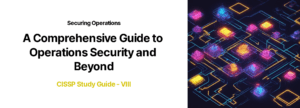Overview
This multi-faceted presentation provides a comprehensive exploration of information security practices, as outlined in the CISSP Study Guide and through various industry-standard asset protection strategies. It navigates through core operations security concepts, safeguarding tangible and intangible assets, and asset lifecycle management, alongside detailed examinations of media management, including RAID systems, advanced storage solutions, and effective backup resource management. Additional coverage encompasses critical practices for data sanitization, network and resource administration, incident response, change management processes, audit essentials, monitoring and reporting methodologies, threat management, and system hardening techniques.
Key Learning Outcomes
- Understand and implement essential operations security policies and procedures such as the need-to-know and least-privilege principles, job rotation, and sensitive information handling.
- Gain insight into protecting organizational assets, including the use of alarms, encrypted tools, and software licensing compliance.
- Master asset management strategies focusing on redundancy, backup systems, and identity and access management for data integrity.
- Delve into data storage redundancy through RAID systems, recognizing each level’s distinct advantages and uses.
- Compare networked storage technologies and their respective applications in the context of organizational needs.
- Examine media management considerations and strategies for maintaining an effective backup and storage environment.
- Learn about best practices in data sanitization and disposal to secure data at the end of its lifecycle.
- Acquire knowledge on ensuring network resilience, resource administration, and managing effective incident response strategies.
- Understand the change management process to smoothly transition operational changes while minimizing impact.
- Explore audit and review essentials for maintaining oversight and effective log file access control.
- Analyze monitoring and reporting techniques tailored to suit technical audience levels while ensuring optimal operational performance.
- Identify and implement proactive threat management strategies and system-hardening measures to guard against vulnerabilities.
Conclusion
Concluding the presentation, participants will have acquired a robust understanding of information security fundamentals, applicable across various domains within the field. A comprehensive grasp of these strategies is paramount in promoting a secure and resilient information environment conducive to organizational success.
Call to Action
Enhance your organization’s cybersecurity strategy by viewing or downloading this insightful presentation. For more information and resources on information security best practices, visit our InfoSec Knowledge Hub. Remember to reference our website appropriately for any use of this material.


